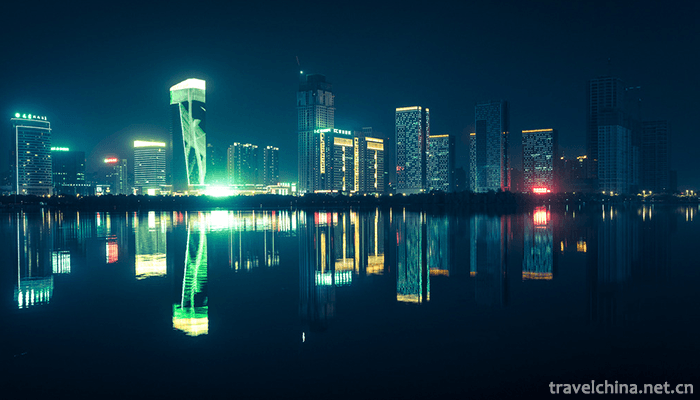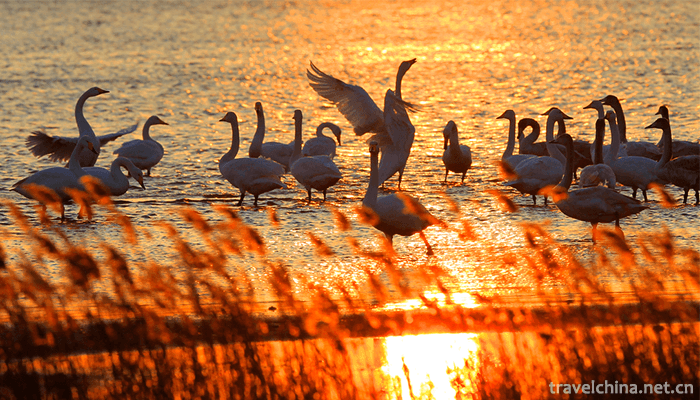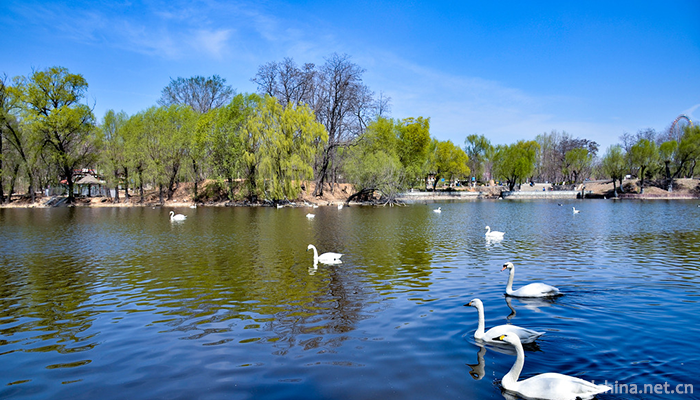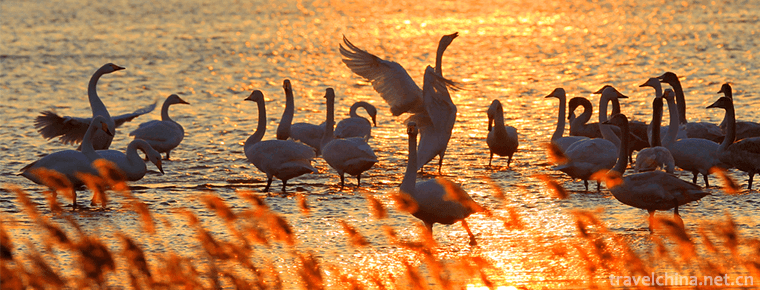Swan Lake National Urban Wetland Park
Swan Lake National Urban Wetland Park
Swan Lake National Urban Wetland Park, located in the ecological zone between the East and West urban areas of Sanmenxia City, covers an area of 8 850 mu, including 6 150 mu of land, 2 700 mu of water surface and beach. The core scenic spots include Shuanglong Lake White Swan Ornamental Area, Shaanzhou Ancient City and the Yellow Eco-Forest Belt. It is a natural landscape area which integrates ecology, culture and human geography.
Park Introduction
The scenic spot is located in the ecological area of the city. It starts from Jinchang overpass in the east, crosses Shaanzhou Avenue in the West with the sightseeing road along the Yellow River, connects Shaanzhou Avenue in the South and Yellow River beach in the north. The planned area is 590 hectares. It is gradually built on the basis of the renovation of the ruins of the old city of Shaanzhou and the two rivers of Qinglong and Canglong. The purpose of planning and construction of Swan Lake Scenic Spot is to make Sanmenxia have a city ecological park with 5,000 mu perennial, 30,000 Mu water surface and 50,000 Mu woodland during water storage period. Every year from November to March, the park attracts tens of thousands of white swans to live here for the winter, so Sanmenxia City is known as the "Swan City".
Scenic spot honor
Swan Lake National Urban Wetland Park, with white swan characteristic resources as its brand and Gushan Island as its center, has gradually formed a natural landscape scenic spot with Yellow River, Qinglong Lake and Canglong Lake as its main body, attracting more and more tourists to stop and linger. The functions of wetland park, such as ecology, tourism, leisure, sightseeing and popular science, have become increasingly prominent.
In February 2007, the park was named Swan Lake National Wetland Park of Sanmenxia City by the Ministry of National Construction, also known as Swan Lake Scenic Area.
In 2011, Swan Lake City Wetland Park in Sanmenxia City was named "National AAAA Tourist Scenic Spot" by the National Tourism Administration.
In 2011, Sanmenxia City was awarded the honorary title of "China's Big Swan Town" by the National Wildlife Conservation Association.




-
1.Fu Ling Rose Crisp
Fuling Rose Crisp is a special traditional snack in Jixi County, Anhui Province. Fuling Rose Crisp is a well-known traditional pastry, which is produced in Fuling Village, Jixi County.
Time 2018-11-27 -
2.Tibetan Fragrance Production Techniques
Tibetan incense is a rare "Tianmu" in the snow-covered mountains of Tibet. There are many records in Buddhist sutras. Tianmuxiang is the top-grade offering of Buddhist rites and buddhism.
Time 2019-04-05 -
3.Chengdu lacquer art
Chengdu lacquer art, the traditional handicraft of Chengdu City, Sichuan Province, is one of the national intangible cultural heritage.
Time 2019-04-18 -
4.Blue Clip Valerian Skills
Blue clip valerian technology, the local traditional printing and dyeing technology of Wenzhou City, Zhejiang Province, is one of the national intangible cultural heritage.
Time 2019-05-11 -
5.Match show
Sai opera is an ancient opera which has been spread in Shanxi, Hebei, Inner Mongolia and Shaanxi. It is a traditional literary form with strong local characteristics of frontier fortress. Sai opera wa
Time 2019-06-12 -
6.Shangdang Bayin Club
Shangdang Bayin Club is a kind of traditional folk wind and percussion music, which is widely spread in Changzhi and Jincheng in southeastern Shanxi Province.
Time 2019-06-13 -
7.Turkish Wheel Autumn
There is a beautiful and magical legend about the origin of Tu's wheel autumn. Legend has it that in order to find a way out of life, the ancestors of the Tu nationality ploughed their fields successi
Time 2019-06-23 -
8.Legend of Xishi
Xishi is the first of the four beautiful women in ancient China. The legend about Xishi was born at the end of Spring and Autumn Period, and has been enriched ever since. Xishi legend takes the war be
Time 2019-07-01 -
9.Processing Technology of Traditional Chinese Medicine
Processing technology of traditional Chinese medicine, one of the means of preparation or extraction of traditional Chinese medicine, is declared by the Chinese Academy of Traditional Chinese Medicine
Time 2019-08-03 -
10.Taoping Qiang Village
Taoping Qiang village is located in Taoping Township, beside Zagunao River in Lixian County. Qiang village is 40 km away from Lixian City, 16 km from Wenchuan city and 139 km from Chengdu. It is a national key cultural relics protection unit and an important scenic spot in Jiuhuang line tourism circle.
Time 2020-11-07 -
11.medical and health work
By the end of 2019, there are 2139 medical and health institutions with 19943 beds. At the end of the year, there were 14351 technical personnel in hospitals and health centers, including 4839 licensed doctors and 6767 registered nurses. The numbe
Time 2020-12-18 -
12.Dazhou landform
The terrain of Dazhou city is high in the Northeast (Daba Mountain Area) and low in the Southwest (Basin hilly area). The highest point is datuanbao, Jichang Township, Xuanhan County, with an altitude of 2458.3 meters; the lowest is Tianguan village, Wan
Time 2020-12-20